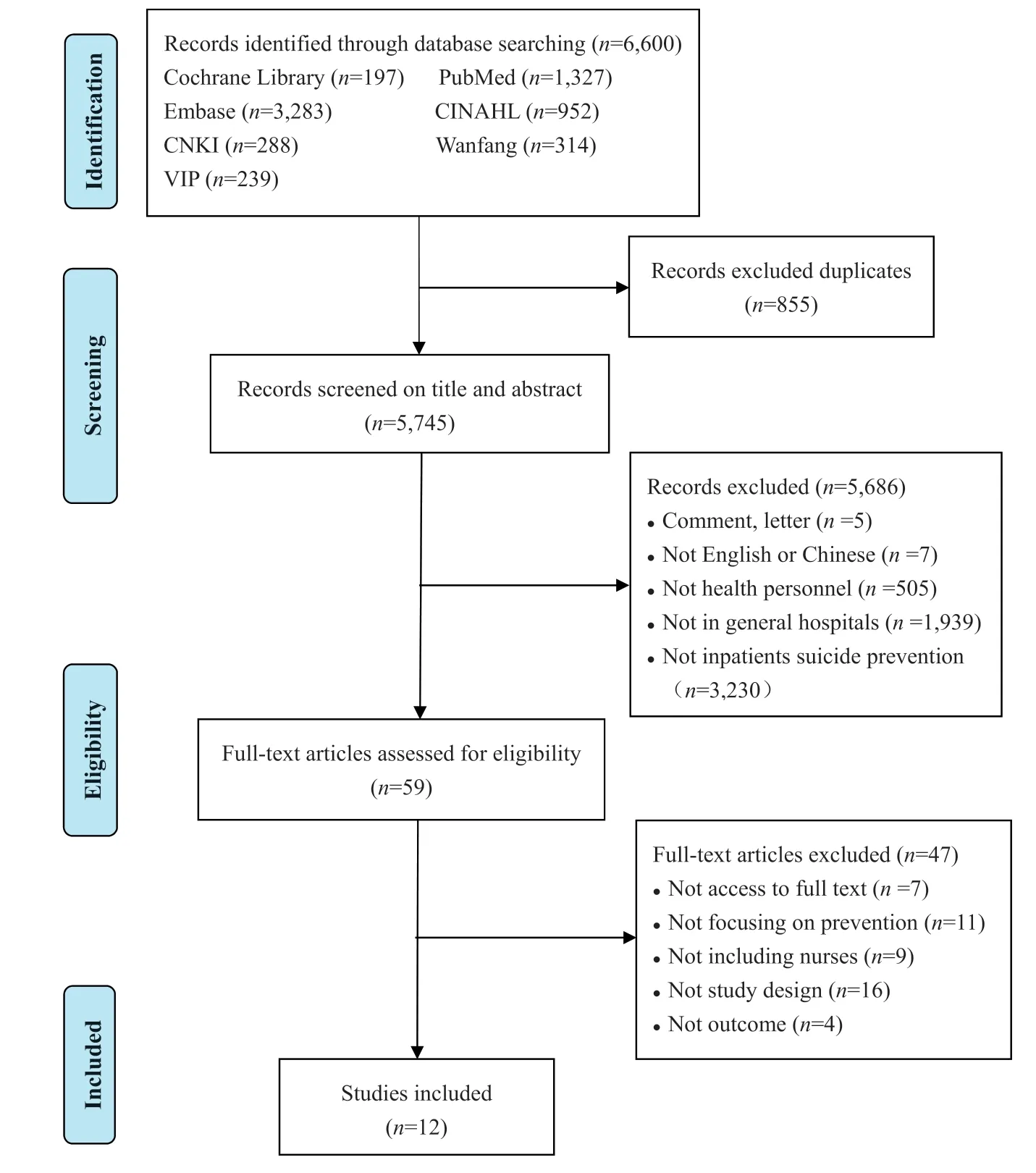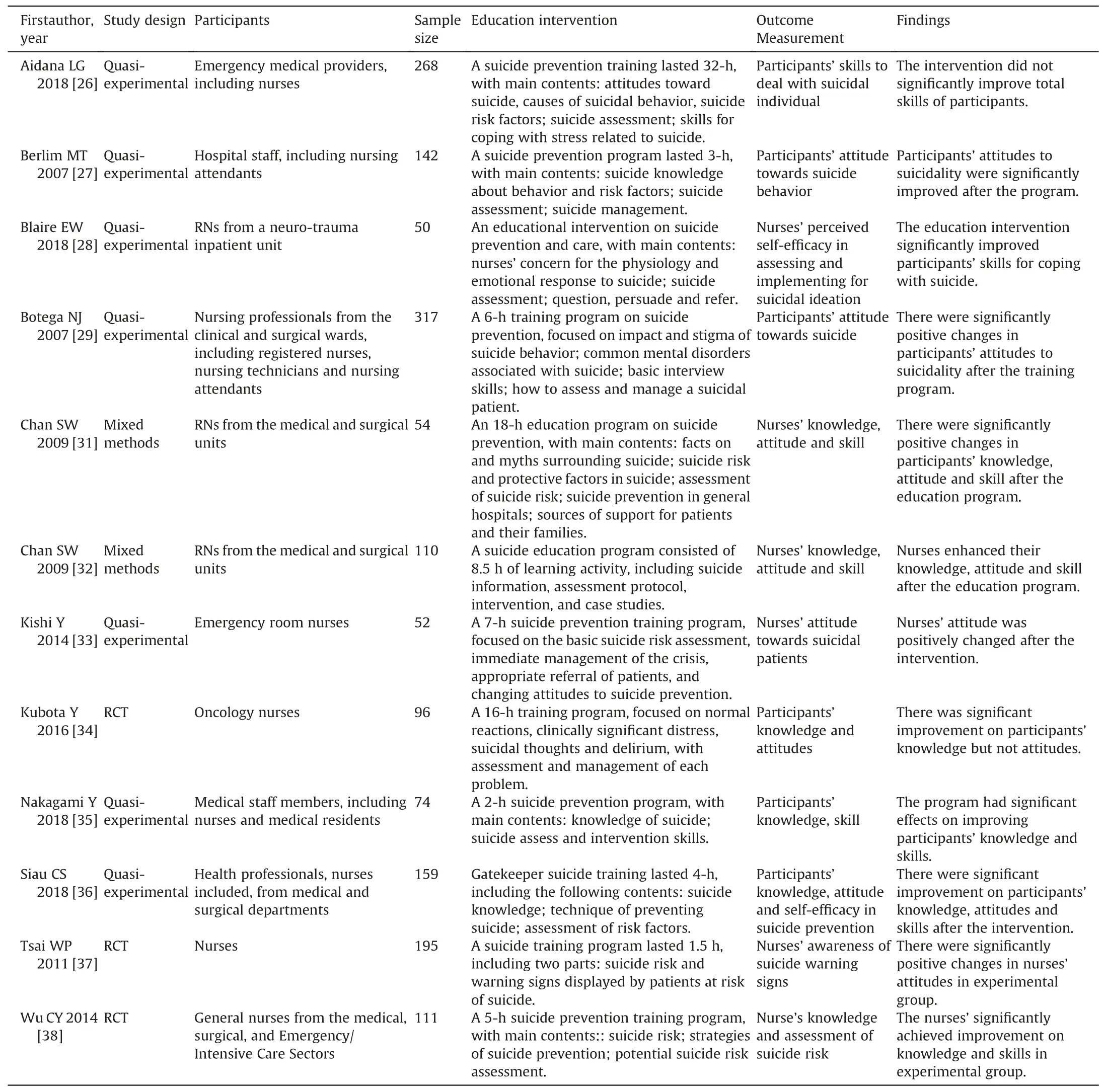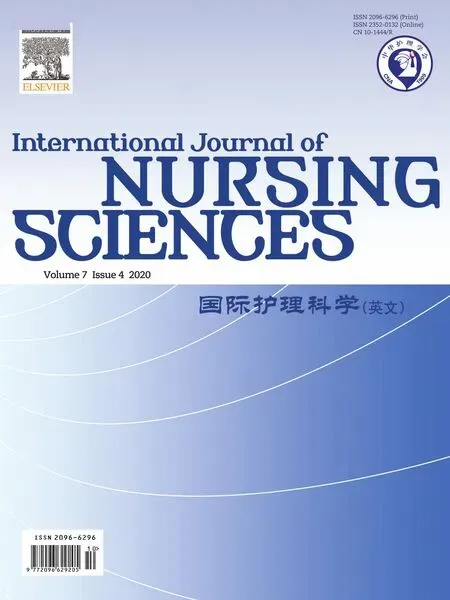Health personnel-targeted education interventions on inpatient suicide prevention in general hospitals:A scoping review
Cuicui Xue ,Yujie Yng ,Kepei Xu ,Xiuxiu Shi ,Huping Liu ,*
a School of Nursing,Peking Union Medical College,Beijing,China
b School of Nursing,Chengde Medical University,Chengde,China
Keywords:General hospital Health personnel Inpatients Patient safety Prevention Safety management Suicide
ABSTRACT Background:Inpatient suicide is an important part of patient safety management in general hospitals.Incidence of inpatient suicide can be decreased by health personnel mastering inpatient suicide prevention strategy.To enhance health personnel’s inpatient suicide prevention strategy,education intervention is a common method.Educational interventions in the researches varied in contents,duration and outcome measurements.However,there has been not synthesis of education interventions targeting health personnel on inpatient suicide prevention.Objective:Prevention of inpatient suicide is a critical priority in patient safety management in general hospitals.Incidence of inpatient suicide can be decreased by effective strategies mastered by health personnel through education interventions.Educational interventions in researches varied in contents,duration and outcome measurements.We aimed to review education interventions targeting health personnel on inpatient suicide prevention.Methods:A scoping review was used to analyze existing researches on education interventions targeting health personnel focusing on inpatient suicide prevention in general hospitals.Cochrane Library,PubMed,Embase,CINAHL,China National Knowledge Infrastructure,WanFang,and Chinese Scientific Journal Database were searched in Oct 2019.According to the inclusion and exclusion criteria,the searched studies were screened by two reviewers.And then,two researchers conducted the data extraction independently by using a table format,including the first author,year of publication,study design,participants,education intervention,etc.Results:Twelve studies were included in this scoping review.The contents of education interventions on inpatient suicide prevention included three aspects:suicide knowledge,suicide assessment,and skills for coping with suicide.The duration of education interventions ranged from 1.5-h to 32.0-h.The effects of education interventions were mainly focused on participants’ knowledge,attitudes and skills of suicide prevention.Conclusion:The evidence showed that education interventions on inpatient suicide prevention had positive impact on health personnel’s knowledge,attitude and skills about inpatient suicide prevention in general hospitals.However,the best health personnel-targeted education intervention on inpatient suicide prevention in general hospitals was yet to be determined.In the future,it is necessary to combine evidence in this review and the actual condition in clinical practice.
What is known?
· Many health personnel who were influenced by harmful effect of inpatient suicide did not receive education interventions on inpatient suicide prevention in general hospitals.
· Education interventions on inpatient suicide prevention can help health personnel increase suicide knowledge,assessment,and coping strategies.
What is new?
· Existing education interventions targeting health personnel on inpatient suicide prevention were varied in contents,duration,and outcome measurement.
· The evidence showed that education interventions on inpatient suicide prevention had positive impact on health personnel’s knowledge,attitude and skills about inpatient suicide prevention in general hospitals.
1.Introduction
Suicide is a significant public health issue around the global.It is the act of intentionallycausing one’s own death[1,2].According to the World Health Organization(WHO)statistics,approximately 800,000 individuals die by suicide each year worldwide.Suicide is the second leading cause of death among adults and adolescents[3].In China,a total of 135,000 people died by suicide in 2015 [4].Although the suicide rate in China dropped sharply,a reversing trend was observed in some certain groups and heavy self-harm burdens still existed[5-8].
Inpatients suicide refers to suicidal thoughts and suicidal behaviors conducted by patients during hospitalizations [9].Rates of inpatient suicide in general hospitals are eight times than the average people [10],and there were approximately 1.5 million inpatients sustained injuries due to suicide globally [11].In China,a report showed that the total number of suicides among nonpsychiatric inpatients from 48 general hospitals,between 2015 and 2017,was 180,and the incidence was 3.26/100,000 [12].
The impact of inpatient suicide is extensive,whether on health personnel or inpatients themselves.Health personnel who experience inpatient suicide are susceptible to mental distress,which have pessimistic impact on their works and lives [13,14].Inpatient suicide deteriorates doctor-patient relationship and even causes medical disputes [15].Suicidal behaviors lead to the result that patients and their families suffer from psychiatric trauma and heavy their economic burden [16,17].
Inpatient suicide prevention has attracted increasing attention worldwide.More and more countries attach importance to the inpatient suicide prevention targeting health personnel,passing legislations and increasing financial support [18,19].Legislations about suicide prevention training among health personnel have been passed in 10 states across the United States[20].Pharmacists should meet the requirement about suicide prevention training in Washington State [21].Administrators pay more attention to interventions targeting health personnel on inpatient suicide prevention in general hospitals.
Education interventions are the most important component of interventions targeting health personnel on inpatient suicide prevention [21,22].Health personnel,mainly including nurses,physicians,surgeons,dentists,pharmacists,are professional intreating and nursing patients.Patients are inclined to believe health personnel’s instructions[23].Evidence showed that education interventions on inpatientsuicidepreventioncanenrichhealth personnel’sknowledge associated with suicide,increase their skills in detection and nursing patient potential for suicide and self-harm,and reduce working environment pressures due to inpatient suicide[24,25].
The researchers searched several studies focused on educational interventions targeting health personnel on inpatient suicide prevention in general hospitals [26-39].However,the educational interventions varied in contents,duration and outcome measurements.Furthermore,we found no review systematized the educational interventions targeting health personnel on inpatient suicide prevention in general hospitals.It is difficult to develop an intervention program selecting suitable contents and measurements in clinical practice.The objective of this study is to review educational interventions targeting health personnel,provide references for developing intervention program targeting health personnel on inpatients suicide prevention,and improve the level of inpatient safety management in general hospitals.
2.Methods
A scoping review was used to map existing inpatient suicide education interventions targeting health personnel in general hospitals.This review followed the five steps of scoping review:1)identifying the research question; 2) identifying relevant studies;3) study selection; 4) charting the data; and 5) collating,summarizing,and reporting the results[30].
2.1.Inclusion and exclusion criteria
Inclusion criteria had four aspects:1) participants were health personnel in general hospitals,including nurses;2) language used in studies were English or Chinese; 3) education interventions on inpatient suicide prevention were related to suicide knowledge,assessment and coping strategies;4)the paper reported the effects of intervention,such as knowledge,attitude or skill.
Exclusion criteria had two aspects:1) health personnel were from psychiatric hospitals;2)full-text of studies were not available;3) studies were comments.
2.2.Search strategy
Chinese and Englishelectronicdatabaseswere bothsearchedfrom their establishments to Oct 2019.The Chinese electronic databases included China National Knowledge Infrastructure(CNKI),Wanfang Database,and VIP Chinese Scientific Journal Database.The English electronic database included Cochrane Library,PubMed,Embase and CINAHL.
After pre-searching,the search strategies were made,combing Mesh terms and free words.The following Mesh terms and free words were used,including (suicide OR suicid*),(health care providers OR nurse OR nurs* OR health personnel OR healthcare worker OR healthcare professional OR medical staff),and (education OR training OR intervention OR prevention).
2.3.Study selection
Removing duplicates of all searched studies was the first step by using Software NoteExpress.Two reviewers (CC Xue and YJ Yang)independently screened studies according to title,abstract and fulltext.The third reviewer(XX Shi)took part in discussion if there was disagreement between the two researchers.
2.4.Data collection
Two researchers (CC Xue and XX Shi) conducted the data collection using a table format including the following information:the first author,year of publication,study design,participants,education intervention,sample size,outcome measurements.

Fig.1.Flow chart of the literature search and selection process.
3.Results
3.1.Study selection
The number of records after database searching was 6,600.Totally 5,745 records were identified after duplicates removed.In the end,59 records were left after screening on title and abstract.After full-text articles being assessed,12 studies were included in this scoping review.The flow chart of the literature searching and selection process was shown in Fig.1.
3.2.Study characteristics
A total of 12 studies were included.There was an increasing yearly number of publications recently,with two-thirds published after 2011 (n=8).Over half of studies came from Asia,China(n=4),Japan(n=3),Brazil(n=2),USA(n=1),Malaysia(n=1),Lithuania (n=1).Most study designs were quasi-experimental(n=7),RCT (n=3),mixed methods (n=2).The participants in 12 studies mainly included nurses,except for other health personnel.Four studies targeted other health personnel except for nurses,such as physicians.Sample size ranged from 50 to 317.Furthermore,the total of sample size in most studies was less than 200 (n=10).Descriptions of the included studies were in Table 1.
3.3.Education interventions on inpatient suicide prevention
3.3.1.Contents of education interventions
The contents of education interventions on inpatient suicide prevention included three aspects:suicide knowledge,suicide assessment,and skills coping with suicide.Ten studies were associated with suicide knowledge,including risk factor of suicide[27,28,31,32,34-38],suicide epidemiology [35,36,38],signs of suicide [35-37],patterns of suicidal behavior [28,36],and impact of suicidal behavior [30].All of the included studies were related to suicide assessment,mainly about suicide risk assessment[27,33-36,38].However,6 studies didn’t account for the contents of assessment [28-32,37].Eleven studies were referred to strategies coping with suicide.Two leading aspects were management of patient at high risk of suicide[28,30,33,34]and referral of patients[28,29,33].
3.3.2.Duration of education interventions
The duration depended on the contents of education interventions.Eleven studies reported the duration of education intervention,except one study [29].The minimum duration was1.5-h in which the content of education interventions was mainly about suicide knowledge[37].The maximum duration was 32-h in which the content of education interventions included suicide knowledge,suicide assessment,and skills coping with suicide[27].Moreover,the mean duration was 9.4-h.

Table 1 Descriptions of the included studies.
3.4.Outcome measurements
The effects of education intervention mainly focused on participants’ knowledge,attitudes and skills of suicide prevention.
3.4.1.Knowledge of suicide
Six studies tested participants’ knowledge of suicide[31,32,34-36,38].Although there was no questionnaire or scale available to measure knowledge of suicide,authors designed some questions as measurements.For example,Kubota [34]developed the knowledge scale with 20-item using the Delphi technique,and Chan [31]used the knowledge test consisted of 12-question resulted from the item bank of mental health nursing texts.The interventions in all studies had significant improvement effects on participants’ knowledge.
3.4.2.Attitude towards to suicide
Seven studies measured participants’ attitudes towards suicide[28,30-34,36].The measurement tools varied in different studies,such as,the Suicide Behavior Attitude Questionnaire [28,30],the Suicide Opinion Questionnaire [31,32],the Understanding Suicidal Patients [33],the Attitudes Toward Caring for Patients Feeling Meaninglessness [34],and the Malay Attitudes Toward Suicide Scale[36].There were significantly positive changes in participants’attitudes after the interventions except one study [34].
3.4.3.Skills for coping with suicide
Eight studies measured participants’ skills [27,29,31,32,35-38].The measurements were various,including existing questionnaires and questions designed by authors.For example,the Suicide Intervention Response Inventory[27]and the Awareness of Suicide Warning Signs Questionnaire [37]were existing questionnaires.Chan et al.[31]used a 10-item questionnaire developed by themselves to test participants’ skill to cope with caring for patients at risk of suicide.The participants significantly achieved improvement on skills after the interventions except one study [27].
4.Discussion
This review suggested that there was a yearly increasing number of publications recently,with two-thirds after 2011(n=8),and half of studies were published in the last five years.It may be related to policy and financial support from governments in different countries.World Health Organization launched Mental Health Action Plan 2013-2020 in 2013,showing that suicide prevention was an important priority and the rate of suicide in countries will be reduced by 10.0%by the year of 2020[39].The National Action Alliance for Suicide Prevention was reported in 2012 in the United States,underling that the education on suicide prevention should be mandated by credentialing and accreditation bodies relating to health professions [40].
Health personnel mainly included nurses and physicians.They acquaint themselves with medical knowledge and therapy and they are professional in treating and nursing inpatients.As a result,patients are inclined to obey physicians and nurses’ instructions.Most health personnel were mainly from emergency room.As we all know,emergency room is the first department that suicide patients receiving treatment.Besides,the patients in emergency room will be at high risk of suicide in the future[41,42].Health personnel in emergency room play a critical role in inpatients suicide prevention [43].Thus,it is meaningful to provide education interventions on inpatient suicide prevention for health personnel in emergency room.
The education interventions mainly included three aspects:suicide knowledge,suicide assessment,and strategies coping with suicide.The contents of education interventions in 10 studies were about suicide knowledge,while 12 studies related to assessment and 11 studies related to strategies.Although the number of studies related to suicide knowledge was the least,it was an important aspect.Suicide knowledge is the basis of suicide assessment and strategies coping with suicide.Firstly,health personnel would pay more attention to inpatient suicide after learning about suicide epidemiology and impact of suicidal behavior.Secondly,health personnel were familiar with risk factor of suicide,signs of suicide,and patterns of suicidal behavior.It will enhance health personnel’s ability of detecting inpatients who are at high risk of suicide.Suicide assessment was essential in the education interventions.Health personnel facilitated their critical thinking,increased their suicide risk assessment competency,and then,making diagnoses of inpatient suicide.Strategies coping with suicide played a leading role in education interventions,making it possible for health personnel to professionally treat and care inpatients who are at high risk of suicide.Therefore,the goal of inpatient suicide prevention may come true.
However,only two studies designed education intervention based on theoretical framework [29,31],and one study followed a document entitled “Preventing Suicide:A Resource for Primary Health Care Workers”published by WHO in 2000[28].It was one of the reasons that the duration of education interventions varied largely,ranging 1.5-h to 32.0-h.Future research should consider using theoretical framework to guide education intervention.
The study outcome measurements were focused on the effects of education interventions,including participants’ knowledge (six studies) [31,32,34-36,38],attitudes (7 studies) [28,30-34,36]and skills for coping with suicide (eight studies) [27,29,31,32,35-38].Although 10 studies designed suicide knowledge in their education interventions [27,28,30-32,34-38],there were only six studies tested participants’ knowledge of suicide [31,32,34-36,38],which all increasing participants’ knowledge of suicide.Thus,suicide knowledge,including suicide risk,protective factors,normal symptoms,can be applied to clinical practice.It can meet health personnel’s clinical needs to prevent inpatient suicide.The reviewers could not be sure why the researches in other four studies did not report suicide regarding knowledge.Several studies indicated that education interventions improved participants’attitude towards inpatient suicide,with one study having no difference in participants’ attitude before and after intervention.Kubota explained that participants’attitudes towards suicide were related to many factors in the clinical setting,for example,participants’job stress [34].Skills for coping with suicide were the most focused object in outcome measurement,which best reflecting that how health personnel apply what they learned in education interventions to their future clinical practice.Seven studies showed that education interventions enhanced participants’skill for coping with suicide,with one study having no difference before and after intervention.Aidana explained that the skills for coping with suicide might be multidimensional,associated with cultural setting and participants’ motivation to change their skills [27].Some related studies indicated that although nurses had adequate knowledge and positive attitude,they may have poor attitude and practice [44].It is necessary for researchers to combine the contents of interventions and clinical settings to strengthen participants’ attitudes and skills in the future.Therefore,the effects of education interventions on inpatient suicide were positive in most studies included in this review.However,the contents,duration and out measurements of the interventions were different in the included studies.Thus,the best health personnel-targeted education intervention on inpatient suicide prevention in general hospitals was yet to be determined.In the future,it is necessary to combine the actual condition and evidence in this review to develop an education intervention targeting health personnel.
5.Limitations
A standardized approach was used in this scoping review,five steps being followed strictly,two independently reviewers participating in studies screening and data extraction.Because of time limitation and availability,seven electronic databases were searched after making searching strategies.Other databases may have more literature.With the limited using right of databases,7 relevant studies were excluded without full-text,not providing evidence for this scoping review.The number of studies included in this review was only 12,may lead to bias in results.Therefore,it is necessary to be cautious when taking this scoping review as reference.Some studies were lack of detailed information about education interventions,especially in the contents of education interventions.The reviewers had trouble ascertaining the implement process of education interventions,which affecting data extraction and result showing.
6.Conclusions
This scoping review provides the evidence that education interventions targeting health personnel on inpatient suicide prevention vary in contents,duration,outcome measurements.Although the best education intervention targeting health personnel was not clarified,most education interventions included in this scoping review had positive impact on health personnel’knowledge,attitude and skills about inpatient suicide in general hospitals.It is necessary to combine evidence in this review with the actual condition in clinical practice.Further research should focus on application of education interventions and the impact on inpatient suicide outcome.
CRediT authorship contribution statement
Cuicui Xue:Methodology,Formal analysis,Investigation,Writing-original draft.Yujie Yang:Formal analysis,Investigation,Data curation.Kepei Xu:Investigation,Data curation.Xiuxiu Shi:Resources,Validation,Visualization.Huaping Liu:Conceptualization,Writing -review &editing.
Declaration of competing interest
All authors declared that there were not any actual or potential conflict of interest including any financial,personal or other relationships with other people or organizations.
Appendix A.Supplementary data
Supplementary data to this article can be found online at https://doi.org/10.1016/j.ijnss.2020.09.006.
 International Journal of Nursing Sciences2020年4期
International Journal of Nursing Sciences2020年4期
- International Journal of Nursing Sciences的其它文章
- The risk factors of postpartum urinary retention after vaginal delivery:A systematic review
- Analysis of the evidence of related factors,associated conditions and at-risk populations of the NANDA-I nursing diagnosis insomnia
- Top 10 cited articles in Scopus:Midwife(2018—2020)
- Development and psychometric evaluation of Nurses and Midwives’Perceptions of their Roles in Primary Healthcare
- Top 10 cited articles in Scopus:Oncology nursing(2018—2020)
- Development and evaluation of the Directive and Nondirective Support Scale for Patients with Type 2 Diabetes
